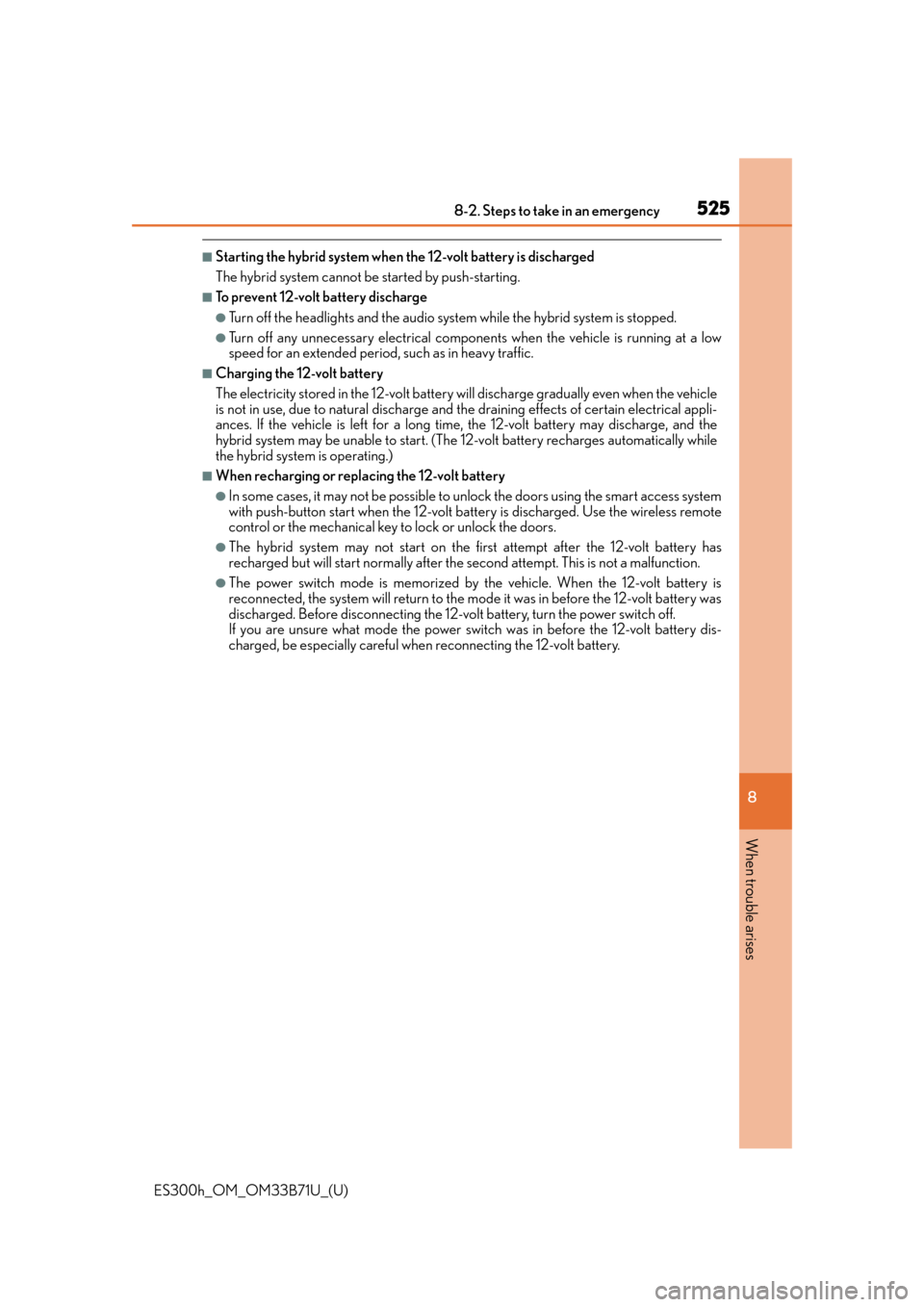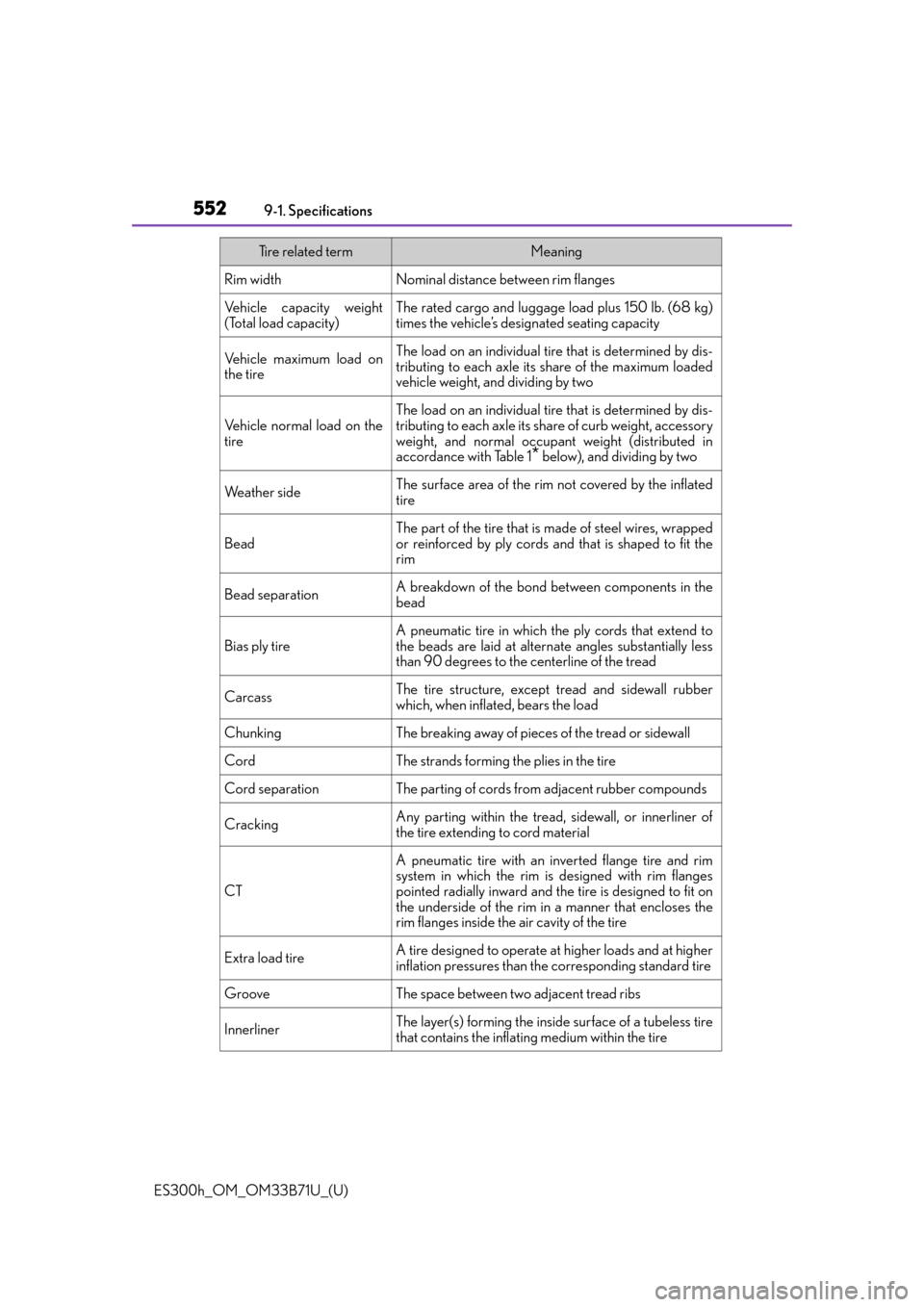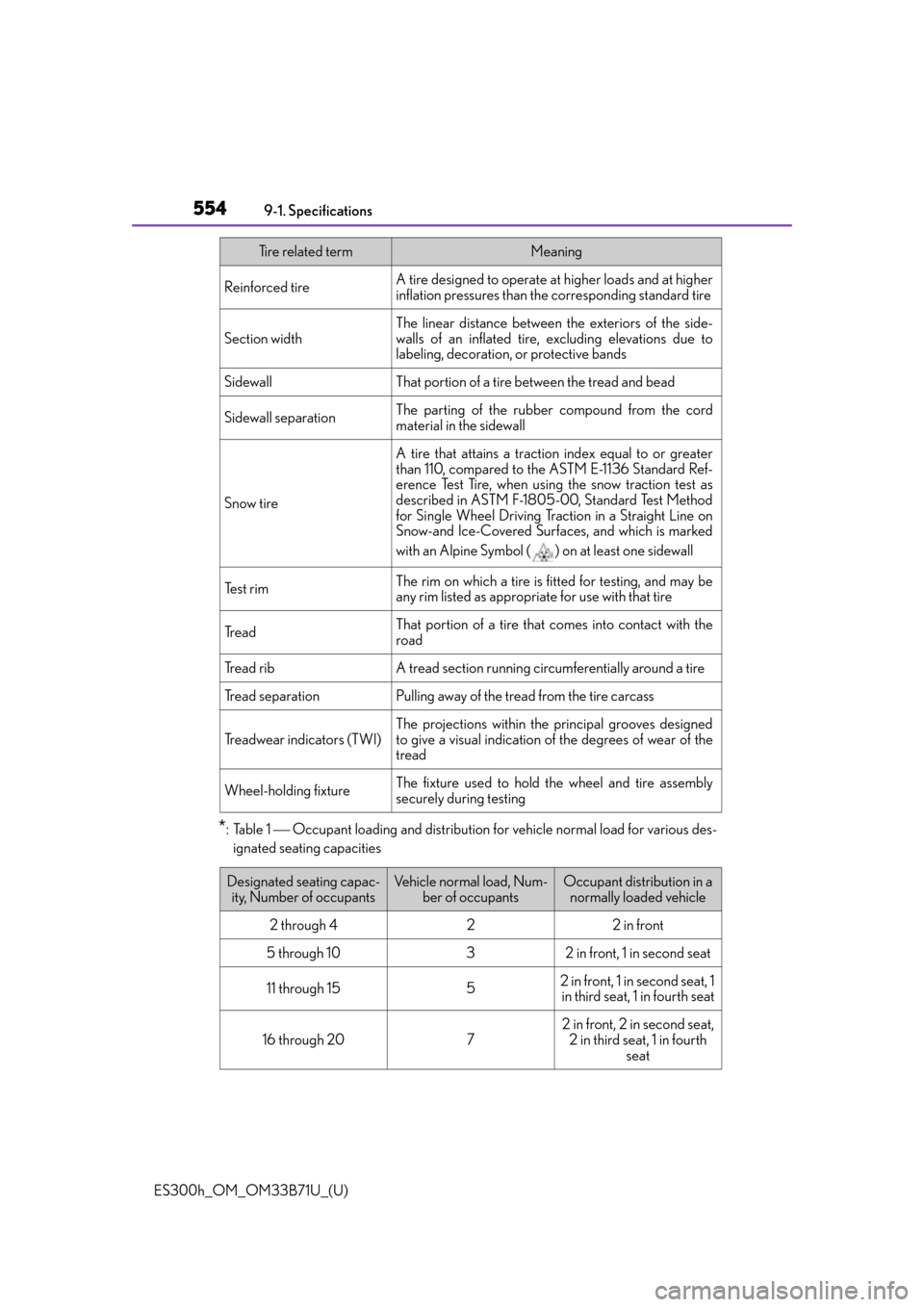ESP Lexus ES300h 2016 (OM33B71U) Repair Manual
[x] Cancel search | Manufacturer: LEXUS, Model Year: 2016, Model line: ES300h, Model: Lexus ES300h 2016Pages: 600, PDF Size: 8.59 MB
Page 525 of 600

5258-2. Steps to take in an emergency
ES300h_OM_OM33B71U_(U)
8
When trouble arises
■Starting the hybrid system when the 12-volt battery is discharged
The hybrid system cannot be started by push-starting.
■To prevent 12-volt battery discharge
●Turn off the headlights and the audio system while the hybrid system is stopped.
●Turn off any unnecessary electrical components when the vehicle is running at a low
speed for an extended period, such as in heavy traffic.
■Charging the 12-volt battery
The electricity stored in the 12-volt battery will discharge gradually even when the vehicle
is not in use, due to natural discharge and the draining effects of certain electrical appli-
ances. If the vehicle is left for a long time, the 12-volt battery may discharge, and the
hybrid system may be unable to start. (The 12-volt battery recharges automatically while
the hybrid system is operating.)
■When recharging or replacing the 12-volt battery
●In some cases, it may not be possible to unlock the doors using the smart access system
with push-button start when the 12-volt battery is discharged. Use the wireless remote
control or the mechanical key to lock or unlock the doors.
●The hybrid system may not start on the first attempt after the 12-volt battery has
recharged but will start normally after the second attempt. This is not a malfunction.
●The power switch mode is memorized by the vehicle. When the 12-volt battery is
reconnected, the system will return to the mode it was in before the 12-volt battery was
discharged. Before disconnecting the 12-volt battery, turn the power switch off.
If you are unsure what mode the power switch was in before the 12-volt battery dis-
charged, be especially careful when reconnecting the 12-volt battery.
Page 530 of 600

5308-2. Steps to take in an emergency
ES300h_OM_OM33B71U_(U)
WA R N I N G
■When inspecting under the hood of your vehicle
Observe the following precautions.
Failure to do so may result in serious injury such as burns.
●If steam is seen coming from under the hood, do not open the hood until the steam
has subsided. The engine compartment may be very hot.
●After the hybrid system has been turned of f, check that the indicator on the power
switch and the “READY” indicator are off.
When the hybrid system is operating, the gasoline engine may automatically start, or
the cooling fan may suddenly operate even if the gasoline engine stops. Do not touch
or approach rotating parts such as the fa n, which may lead to fingers or clothing
(especially a tie, a scarf or a muffler) ge tting caught, resulting in serious injury.
●Do not loosen the radiator cap or the co olant reservoir cap while the hybrid system
and radiator are hot. High temperature steam or coolant could spray out.
NOTICE
■When adding engine/power control unit coolant
Add coolant slowly after the hybrid system has cooled down sufficiently. Adding cool
coolant to a hot hybrid system too quickly can cause damage to the hybrid system.
■To prevent damage to the cooling system
Observe the following precautions:
●Avoid contaminating the coolant with foreign matter (such as sand or dust etc.).
●Do not use any coolant additives.
Page 550 of 600

550
ES300h_OM_OM33B71U_(U)9-1. Specifications
■Tr a c t i o n A A , A , B , C
The traction grades, from highest to lowest, are AA, A, B and C, and they rep-
resent the tire’s ability to stop on we
t pavement as measured under controlled
conditions on specified government te st surfaces of asphalt and concrete.
A tire marked C may have poor traction performance.
Warning: The traction grade assigned to this tire is based on braking (straight
ahead) traction tests and does not include cornering (turning) traction.
■Temperature A, B, C
The temperature grades are A (the highes t), B, and C, representing the tire’s
resistance to the generation of heat and its ability to dissipate heat when
tested under controlled conditions on a specified indoor laboratory test
wheel.
Sustained high temperature can cause the material of the tire to degenerate and
reduce tire life, and excessive temperature can lead to sudden tire failure.
Grade C corresponds to a level of perfor mance which all passenger car tires must
meet under the Federal Motor Vehicle Safety Standard No. 109.
Grades B and A represent higher levels of performance on the laboratory test
wheel than the minimum required by law.
Warning: The temperature grades of a tire assume that it is properly inflated and
not overloaded.
Excessive speed, underinflation, or excessiv e loading, either separately or in com-
bination, can cause heat buildup and possible tire failure.
Page 552 of 600

552
ES300h_OM_OM33B71U_(U)9-1. Specifications
Rim widthNominal distance between rim flanges
Vehicle capacity weight
(Total load capacity)The rated cargo and luggage load plus 150 lb. (68 kg)
times the vehicle’s designated seating capacity
Vehicle maximum load on
the tireThe load on an individual tire
that is determined by dis-
tributing to each axle its share of the maximum loaded
vehicle weight, and dividing by two
Vehicle normal load on the
tireThe load on an individual tire that is determined by dis-
tributing to each axle its sh are of curb weight, accessory
weight, and normal occupant weight (distributed in
accordance with Table 1
* below), and dividing by two
We a t h e r s i d eThe surface area of the rim not covered by the inflated
tire
Bead
The part of the tire that is made of steel wires, wrapped
or reinforced by ply cords and that is shaped to fit the
rim
Bead separationA breakdown of the bond be tween components in the
bead
Bias ply tire
A pneumatic tire in which the ply cords that extend to
the beads are laid at altern ate angles substantially less
than 90 degrees to the centerline of the tread
CarcassThe tire structure, except tread and sidewall rubber
which, when inflated, bears the load
ChunkingThe breaking away of pieces of the tread or sidewall
CordThe strands forming th e plies in the tire
Cord separationThe parting of cords from adjacent rubber compounds
CrackingAny parting within the tread, sidewall, or innerliner of
the tire extending to cord material
CT
A pneumatic tire with an inverted flange tire and rim
system in which the rim is designed with rim flanges
pointed radially inward and the tire is designed to fit on
the underside of the rim in a manner that encloses the
rim flanges inside the air cavity of the tire
Extra load tireA tire designed to operate at higher loads and at higher
inflation pressures than the corresponding standard tire
GrooveThe space between two adjacent tread ribs
InnerlinerThe layer(s) forming the inside surface of a tubeless tire
that contains the inflating medium within the tire
Tire related termMeaning
Page 554 of 600

554
ES300h_OM_OM33B71U_(U)9-1. Specifications
*:Table 1
Occupant loading and distribution fo r vehicle normal load for various des-
ignated seating capacities
Reinforced tire A tire designed to operate at higher loads and at higher
inflation pressures than the corresponding standard tire
Section width
The linear distance between the exteriors of the side-
walls of an inflated tire, excluding elevations due to
labeling, decoration, or protective bands
SidewallThat portion of a tire between the tread and bead
Sidewall separationThe parting of the rubber compound from the cord
material in the sidewall
Snow tire
A tire that attains a traction index equal to or greater
than 110, compared to the ASTM E-1136 Standard Ref-
erence Test Tire, when using the snow traction test as
described in ASTM F-1805-00, Standard Test Method
for Single Wheel Driving Tract ion in a Straight Line on
Snow-and Ice-Covered Surfaces, and which is marked
with an Alpine Symbol ( ) on at least one sidewall
Te s t r i mThe rim on which a tire is fitted for testing, and may be
any rim listed as appropriate for use with that tire
Tr e a dThat portion of a tire that comes into contact with the
road
Tr e a d r i bA tread section running circumferentially around a tire
Tread separationPulling away of the tread from the tire carcass
Treadwear indicators (TWI)
The projections within the principal grooves designed
to give a visual indication of the degrees of wear of the
tread
Wheel-holding fixtureThe fixture used to hold the wheel and tire assembly
securely during testing
Tire related termMeaning
Designated seating capac- ity, Number of occupantsVehicle normal load, Num- ber of occupantsOccupant distribution in a normally loaded vehicle
2 through 422 in front
5 through 1032 in front, 1 in second seat
11 through 1552 in front, 1 in second seat, 1 in third seat, 1 in fourth seat
16 through 207
2 in front, 2 in second seat,
2 in third seat, 1 in fourth seat
Page 576 of 600

576
ES300h_OM_OM33B71U_(U)
AVERTISSEMENT
■Précautions relatives aux coussins gonflables SRS
●Si un recouvrement de vinyle est placé sur la zone de déploiement du coussin gonfla-
ble SRS de protection des genoux, veillez à le retirer.
●N’utilisez pas d’accessoires recouvrant les pa rties du siège où les coussins gonflables
SRS latéraux se déploient, car ces access oires pourraient entraver le déploiement
des coussins gonflables. De tels accessoir es peuvent empêcher les coussins gonfla-
bles latéraux de se déployer correctement, rendre le système inopérant ou provo-
quer accidentellement le déploiement des coussins gonflables latéraux,
occasionnant des blessures graves, voire mortelles.
●Ne frappez pas et n’appliquez pas une pr ession importante à l’emplacement des
composants des coussins gonflables SRS.
Cela peut provoquer un mauvais foncti onnement des coussins gonflables SRS.
●Ne touchez à aucun composant des coussins gonflables SRS immédiatement après
leur déploiement (gonflage), car ils pourraient être chauds.
●Si vous avez de la difficulté à respirer après le déploiement des coussins gonflables
SRS, ouvrez une portière ou une glace pour laisser entrer l’air, ou quittez le véhicule
si vous pouvez le faire en toute sécurité. Dès que possible, nettoyez tous les résidus
afin d’éviter les irritations cutanées.
●Si les emplacements de stockage des coussi ns gonflables SRS, tels que le tampon de
volant et les garnitures des montants avan t et arrière, sont endommagés ou fissurés,
faites-les remplacer par votre concessionnaire Lexus.
■Modification et mise au rebut des compos ants du système de coussins gonflables
SRS
Ne mettez pas votre véhicule au rebut et n’effectuez aucune des modifications suivan-
tes sans d’abord consulter votre concessio nnaire Lexus. Les coussins gonflables SRS
pourraient fonctionner de manière incorrecte ou se déployer (gonfler) accidentelle-
ment, ce qui serait susceptible d’occasion ner des blessures graves, voire mortelles.
●Installation, retrait, démontage et réparation des coussins gonflables SRS
●Réparations, modifications, retrait ou remplacement du volant, du tableau de bord,
de la planche de bord, de la boîte à gants, des sièges ou du capitonnage des sièges,
des montants avant, latéraux et arrière, ou des brancards de pavillon
●Réparations ou modifications de l’aile av ant, du pare-chocs avant ou du côté de
l’habitacle
●Installation d’une protection de calandre (barre safari, barre kangourou, etc.), de
lames de déneigement ou de treuils
●Modifications du système de suspension du véhicule
●Installation d’appareils électroniques tels qu’un émetteur-récepteur radio ou un lec-
teur de CD
●Modifications à votre véhicule pour une personne aux capacités physiques réduites